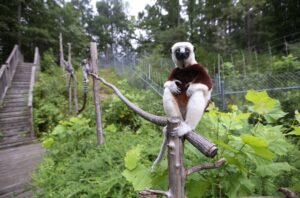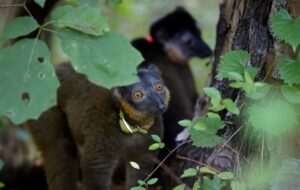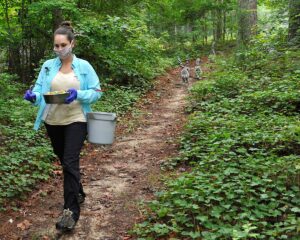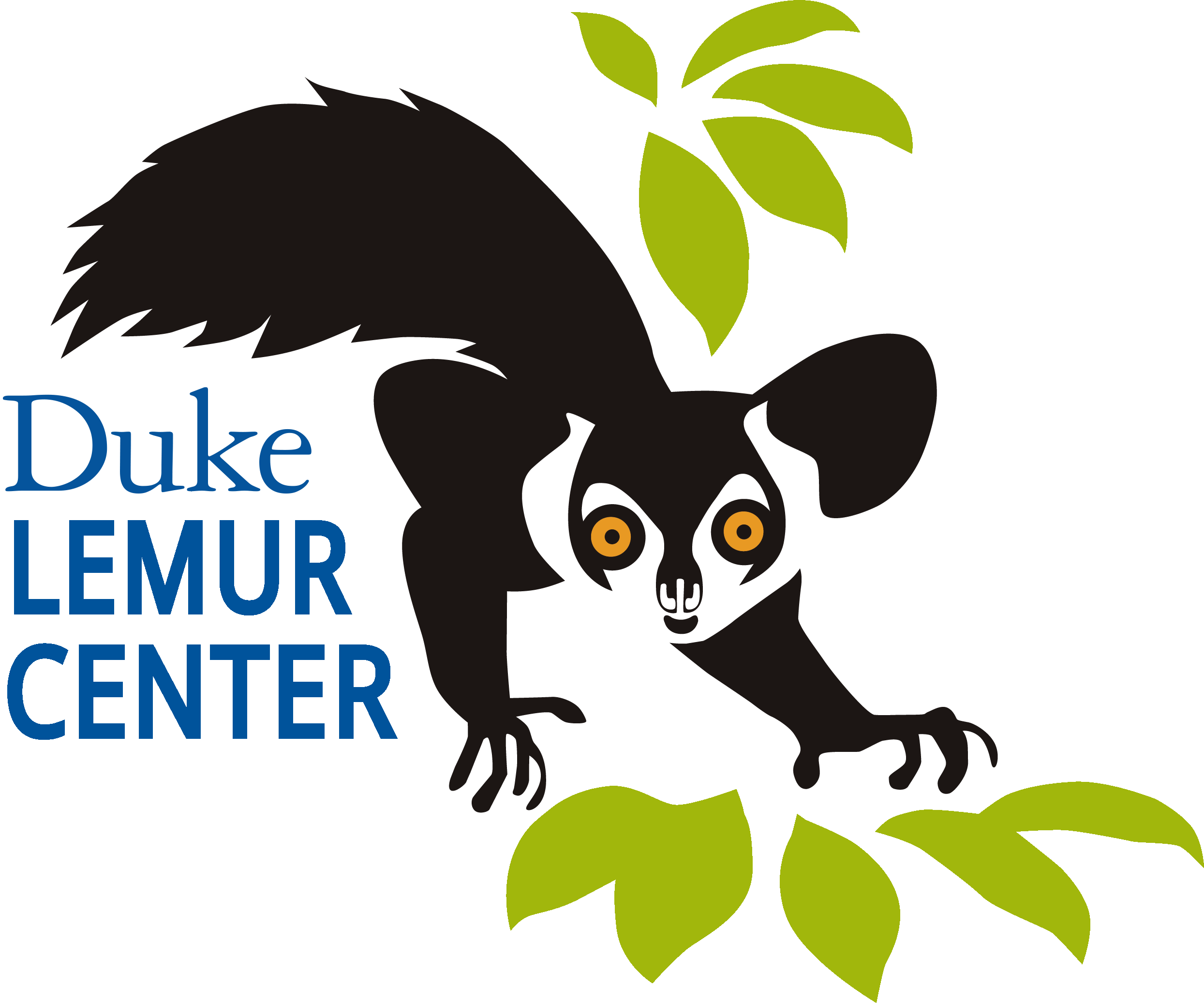This Summer in the Natural Habitat Enclosures
One of the hallmarks of the DLC is its Natural Habitat Enclosures, where lemurs free-range in large tracts of forest and live in natural social groups, giving researchers and visitors the opportunity to observe the lemurs leaping and socializing with each other in a natural setting, without the need to travel thousands of miles to Madagascar.
There are nine Natural Habitat Enclosures (NHEs) at the Duke Lemur Center, ranging in size from one to 13+ acres. From late spring to early fall, NHEs allow the resident lemurs to explore the forest 24 hours a day – with activities ranging from a nap on the soft, shady ground to foraging for fresh leaf buds over 80 feet up in a tulip poplar tree.

The NHE 3 lemurs wait for breakfast to be delivered.
Each winter, Animal Curator Cathy Williams carefully works with the animal care team to plan for the spring animal moves. Just a few of the questions to be considered in this planning are…
Does this troop have a breeding recommendation this year?
What’s this lemur’s temperament toward humans? How about other lemurs?
Which lemurs have historically done well in this NHE?
Is this lemur scheduled to move to a zoo halfway across the country in the middle of the summer?
Is there enough space for one more species in this NHE?
How much staff time will be needed to introduce a new troop to this NHE safely?
With so many questions to consider, determining which lemurs will reside in which forests is like the ultimate brain teaser. So, what’s a curator to do? Compromise! Most of the 2020 NHE line-ups include a couple of experienced free-ranging troops, paired with some new lemurs experiencing their NHE for the first time.

Didius learns the ropes in the NHE by watching his mom very, very closely.
Coquerel’s sifaka Gisela is an expert free-ranger, who has lived in NHE 2 for the past six years. This year’s infant, Didius, is the third that she has successfully reared as a free-ranging pro. Lemur infants raised as forest free-rangers tend to have an easier time adjusting to new environments as they get older, even taking to a new NHE with more confidence as an adult.

Pompeia and Francesca repurpose a food basket for a snuggle session in NHE 1.
When 11-year-old Coquerel’s sifaka Pompeia was introduced to NHE 1 in 2019, her free-ranging experience as an infant shined, and she immediately took to the trees with gusto. Her four-year-old daughter Francesca, on the other hand, was experiencing the forest for the first time; and the younger sifaka’s lack of experience resulted in some comical missteps. Primary caretaker Melanie Currie even joked that hard hats might be necessary after observing Francesca miss a few big jumps and land unceremoniously on the ground and comically far from her original destination. No primates were truly injured in Francesca’s learning process, and after a few weeks, Francesca had fully adjusted to life in NHE 1, where she and her mother are thriving.

Crowned lemurs Aria and Anhotep are excellent companions to each other.
Introducing new lemurs into an NHE does not always go to plan, as was the case of crowned lemurs Aria and Anhotep in NHE 8 this summer. These two lemurs are beloved by staff and visitors alike, and their spectacular performances in training sessions combined with their mild temperaments presented them as ideal free-ranging candidates. After a smooth start introducing the crowned lemur pair into a smaller fenced area within the NHE, things went unexpectedly south when the first full introductions began with Aria immediately chasing her new ring-tailed neighbors.

Tellus and Licinius are long-term residents of NHE 8.
After two unsuccessful introduction attempts, the animal care team decided that the lemurs already residing – and peacefully coexisting – in NHE 8 should be prioritized. Aria and Anhotep are now happily back to living in a combination indoor/outdoor habitat, where they receive extra attention from the animal care staff in the form of multiple meal times and enrichment – routine practice to ensure an excellent quality of life for all non-free-ranging lemurs.

Mae and Judith explore the path that leads deeper into NHE 3.
Two-year-old red ruffed lemurs Mae and Judith had a more successful, if slightly complicated, introduction to NHE 3 this year. As first-time free-rangers, the sisters were initially hesitant to leave the familiar territory of their attached indoor enclosure to explore the forest. Curator of Behavioral Management Meg Dye worked with animal care staff to use positive reinforcement training to encourage more confident forest-exploring from the sisters.

Judith and her sister gain more confidence with every week spent in the forest.
As Mae and Judith gained confidence in the forest, their caretakers introduced their new neighbors, with mixed results. While introductions with the resident Coquerel’s sifakas and ring-tailed lemurs went smoothly, blue-eyed black lemur (and new mom) Leigh showed some aggression toward the newest additions to the habitat. Since Mae and Judith were not instigating issues, the animal care team decided on a compromise: Mae and Judith free-range for part of the week, while Leigh’s troop stays in the building on a more pampered meal and enrichment schedule; and then they switch, alternating to allow both groups the benefits of free-ranging.

Odette and Dozier enjoy some shade during a hot NC summer day.
The runaway success of the 2020 NHE lineup is collared lemur mom and son, Odette and Dozier. Their initial introduction started in a smaller fenced area within NHE 6, familiarizing them to the sights and sounds of the forest and to their new Coquerel’s sifaka and ring-tailed neighbors. Once fully introduced to the NHE, Odette and Dozier thrived. Primary caretaker Allie Blackwood is thrilled to have them in the NHE: “When they’re out in the forest, their personalities are just magnified – Odette as the sweet and patient one, Dozier as the bossy and eager one – and they make the enclosure feel complete.”

Animal care technician Danielle heads out to feed NHE 4.
From organizing the puzzle of colony management, to painstakingly training lemurs to hop down onto the forest floor despite the new and decidedly spooky texture of pine needles beneath their feet, successfully introducing lemurs to free-ranging in an NHE is an incredible amount of work for the animal care team. But ask any one of them whether they think the effort is worth it, and they might laugh at the silliness of such a question. To that dedicated team, the reward of seeing the animals thrive and play in a natural setting, exploring the trees as they would in the wild, is plenty justification for the hours of work that make it possible.

